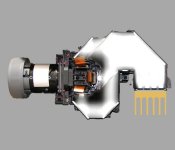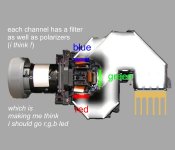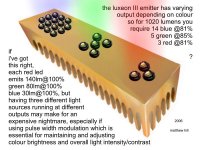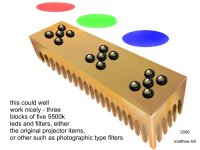thanks stelleg and morkys!
a guy called RAGEdemon has actually managed to replace his uhp lamp with a cheaper, similar one, but he says that the resistors get incredibly hot, and therefore there is no energy saving to be had that way, so (once i've had advice on how to do it) i want to trick the control circuit electronically and so massively reduce the energy requirement of the pj
compared to you fellows i'm not a "real" innovator, what you're all doing is very cool indeed
below is a picture of the complex path the light from a white led would have to take, negotiating filters and possibly polarizers and losing much of the output
a guy called RAGEdemon has actually managed to replace his uhp lamp with a cheaper, similar one, but he says that the resistors get incredibly hot, and therefore there is no energy saving to be had that way, so (once i've had advice on how to do it) i want to trick the control circuit electronically and so massively reduce the energy requirement of the pj
compared to you fellows i'm not a "real" innovator, what you're all doing is very cool indeed
below is a picture of the complex path the light from a white led would have to take, negotiating filters and possibly polarizers and losing much of the output
Attachments
throwit said:and this is what my luxeon III lamp might look like (with a few wires of course)
16 leds at 3.5V*1A=3.5W each draw 56 watts, and produce 1280 lumen maximum, requiring a copper heatsink (thus most of these 56 watts are wasted into heat) and a special power supply (56V regulated at 1A assuming series connection).
That's funny in terms of efficiency, because there are $3 fluorescent lamps that produce 900 lumen with 11W and no heatsinks so far 😀
Stell:
Yeah, on the far side of the lcd. yeah, hopefully you guys will get more than what i had quoted. Let me know.
Yeah, on the far side of the lcd. yeah, hopefully you guys will get more than what i had quoted. Let me know.
the more i look at all the mirrors and stuff in there, the more i want to rip out everything outside of the lcds themselves, then i got to thinking that maybe i should just direct light each of the three channels, like below...
Attachments
Eva said:
16 leds at 3.5V*1A=3.5W each draw 56 watts, and produce 1280 lumen maximum, requiring a copper heatsink (thus most of these 56 watts are wasted into heat) and a special power supply (56V regulated at 1A assuming series connection).
That's funny in terms of efficiency, because there are $3 fluorescent lamps that produce 900 lumen with 11W and no heatsinks so far 😀
hi Eva, not sure if they are so terribly innefficient, it may just be about cooling for efficiency (small amount of localised heat within emitter)
Eva said:
16 leds at 3.5V*1A=3.5W each draw 56 watts, and produce 1280 lumen maximum, requiring a copper heatsink (thus most of these 56 watts are wasted into heat) and a special power supply (56V regulated at 1A assuming series connection).
That's funny in terms of efficiency, because there are $3 fluorescent lamps that produce 900 lumen with 11W and no heatsinks so far 😀
Holy crap, these luxeons take 1A??? The ones I plan on ordering run at the usual 20mA @ 3.3v. That explains the intense heat and light created by them.
throwit said:the more i look at all the mirrors and stuff in there, the more i want to rip out everything outside of the lcds themselves, then i got to thinking that maybe i should just direct light each of the three channels, like below...
I cant really tell how your projector works by the diagram. Can you tell if there are green, red and blue filters in place already? That would be the only situation that would give you the option for what you are planning.
If thats not the case, and the light from the original bulb was just reflected 3 ways, then maybe just do the same setup as you have except with white LEDs for all 3 sections instead of colored ones.
Basically its kinda hard to give advice when we have no idea how the projector is projecting through those LCDs and what each of the LCDs is displaying, so maybe work on figuring that out more before deciding what to buy.
Also, could you give me a link to the spec page for those LEDs?
Keep at it, I think it could be done, and will be very cool in the end.
sure thing...luxeon III emitter
okay, i've seen photos of the inside of sanyo z4 lcd front pj, and it has in order...the lamp, what i have been told looks like a shatter guard, then there's what looks like a polarizer or uv filter of some kind (has weird rectangular sections within it), then a mirror to reflect blue light somehow (with polarizer ?) to the upper lcd which has a blue filter that should be removable, at the point of the blue mirror, yellow and red light continues on until yellow reflector which sends light through green filter to 'green' lcd, and finally the red goes through a red filter to the final 'red' lcd
i now think that my best option might be to use the three rgb colours from start and rip out the filters/polarizers etc
a picture of the led lamp i'm thinking about is to follow soon
...thanks 🙂
okay, i've seen photos of the inside of sanyo z4 lcd front pj, and it has in order...the lamp, what i have been told looks like a shatter guard, then there's what looks like a polarizer or uv filter of some kind (has weird rectangular sections within it), then a mirror to reflect blue light somehow (with polarizer ?) to the upper lcd which has a blue filter that should be removable, at the point of the blue mirror, yellow and red light continues on until yellow reflector which sends light through green filter to 'green' lcd, and finally the red goes through a red filter to the final 'red' lcd
i now think that my best option might be to use the three rgb colours from start and rip out the filters/polarizers etc
a picture of the led lamp i'm thinking about is to follow soon
...thanks 🙂
Attachments
this review of the sanyo z4 shows the kind of shenanigans that go on inside a projector...
sanyo z4 in bits
sanyo z4 in bits
Looks good man. I think actually going red-green-white might work well, as the filters after the white would probably reduce ouput significantly. Thanks for the linky too, its cool to see how these commercial projectors work.
Anyways, I would recommend red&green&white for best efficiency, although you might have to play with the resistor values to get a more accurate overall color balance.
Keep it up, the plans look great.
Anyways, I would recommend red&green&white for best efficiency, although you might have to play with the resistor values to get a more accurate overall color balance.
Keep it up, the plans look great.
hi stelleg
thanks for the encouragement 🙂
but i'd like you to elaborate on something - i don't understand "red-green-white"...did you mean red-green-blue, or is there an advantage to using a white led lamp on the blue channel (with filter) as opposed to blue led ? - is it that i can use fewer white with filter and still get same brightness (say 9 white 80lm each run @ 83% = 598lm run through blue filter with 57% throughput = 340lm/matching red and green channels ?)
it's a bit strange really these leds, i mean that for even output i thought i would need...
3 red (the most powerful - wish all colours put out 140lm each ! to be run @ 81%)
5 green (80lm each run @85%)
14 blue (30lm each run @81%) for three x 340lm @ +/- 83% - total 1020lm
(doesn't sound like much i know, but i'm hoping for 50% efficiency if all channels pre-tinted, so no other filters and certainly no polarizers required)
my thinking is that have each channel running pwm, i can add far greater gamma and brightness as well as contrast adjustment
thanks for the encouragement 🙂
but i'd like you to elaborate on something - i don't understand "red-green-white"...did you mean red-green-blue, or is there an advantage to using a white led lamp on the blue channel (with filter) as opposed to blue led ? - is it that i can use fewer white with filter and still get same brightness (say 9 white 80lm each run @ 83% = 598lm run through blue filter with 57% throughput = 340lm/matching red and green channels ?)
it's a bit strange really these leds, i mean that for even output i thought i would need...
3 red (the most powerful - wish all colours put out 140lm each ! to be run @ 81%)
5 green (80lm each run @85%)
14 blue (30lm each run @81%) for three x 340lm @ +/- 83% - total 1020lm
(doesn't sound like much i know, but i'm hoping for 50% efficiency if all channels pre-tinted, so no other filters and certainly no polarizers required)
my thinking is that have each channel running pwm, i can add far greater gamma and brightness as well as contrast adjustment
i think some of my previous posts may have been confusing (i'm definately confusing myself !)
to (hopefully) clarify, option one below involves just replacing the light source and using the projectors own existing filters, option two is to use coloured leds and rip out the projectors own filters, option three is to use white leds, but replace the original filters with higher light throughput camera/photographic or other filters
(from my avforumsuk thread )
so it looks like it's coming down to three main choices...
1...use the original light pathway minus polarizers and a 5500k led lamp in the original space - colour reflective mirrors may block too much of the light - pwm would add major contrast improvement and adjustability (would probably need two pwm supplies because of output limitataions)
lamp parts/costs 16 5500k leds ($55.20 total) plus two dimmable pwm power supplies, 45mmx45mmx45mm heatsink, ancilliaries
2...rip nearly everything out and use three seperate led light sources (rgb) directly lighting the lcds - may be the best way, and although it would require three pwm supplies, it would add another rgb adjust facility whilst simultaneously adding major contrast adjust improvement
lamp parts/costs 14 blue leds $40.04, 5 green leds $14.30, 3 red leds $12.09 ($66.43 total) plus three dimmable pwm power supplies, 150mmx45mmx45mm heatsink, ancilliaries
3...similar to above, but use three white led lamps with coloured filters - but will coloured filters be more light efficient than the pj originals, and will they block identical amounts to leave identical light throughput for each channel ?
lamp parts/costs 15 5500k leds ($51.75 total) plus three dimmable pwm power supplies, 150mmx45mmx45mm heatsink, ancilliaries
to (hopefully) clarify, option one below involves just replacing the light source and using the projectors own existing filters, option two is to use coloured leds and rip out the projectors own filters, option three is to use white leds, but replace the original filters with higher light throughput camera/photographic or other filters
(from my avforumsuk thread )
so it looks like it's coming down to three main choices...
1...use the original light pathway minus polarizers and a 5500k led lamp in the original space - colour reflective mirrors may block too much of the light - pwm would add major contrast improvement and adjustability (would probably need two pwm supplies because of output limitataions)
lamp parts/costs 16 5500k leds ($55.20 total) plus two dimmable pwm power supplies, 45mmx45mmx45mm heatsink, ancilliaries
2...rip nearly everything out and use three seperate led light sources (rgb) directly lighting the lcds - may be the best way, and although it would require three pwm supplies, it would add another rgb adjust facility whilst simultaneously adding major contrast adjust improvement
lamp parts/costs 14 blue leds $40.04, 5 green leds $14.30, 3 red leds $12.09 ($66.43 total) plus three dimmable pwm power supplies, 150mmx45mmx45mm heatsink, ancilliaries
3...similar to above, but use three white led lamps with coloured filters - but will coloured filters be more light efficient than the pj originals, and will they block identical amounts to leave identical light throughput for each channel ?
lamp parts/costs 15 5500k leds ($51.75 total) plus three dimmable pwm power supplies, 150mmx45mmx45mm heatsink, ancilliaries
I have managed to get a lux meter. But I am concerned about my projector now! I am still waiting on the Luxeon. The K2 (the new ones that emit 113 lumens) are on backorder for 10 weeks. So maybe I will get a Luxeon V or III just to get started. I am concerned because my screen readings appear something like this:
6 13 6
8 31 9
6 18 6
Those are about the numbers (I can't remember the exact numbers). The average (add them up and divide by 9) is 13 lux! I have a 1.5m x 1.2m screen which is a 1.8 meter squared area. That means I'm getting around 23.4 lumens on my screen!! Something is not right. I did happen to look at the manual and see that it was calibrated with a 2700K (ish) bulb. I'm hoping the calibration is off because that's a DULL screen compared to many here.
6 13 6
8 31 9
6 18 6
Those are about the numbers (I can't remember the exact numbers). The average (add them up and divide by 9) is 13 lux! I have a 1.5m x 1.2m screen which is a 1.8 meter squared area. That means I'm getting around 23.4 lumens on my screen!! Something is not right. I did happen to look at the manual and see that it was calibrated with a 2700K (ish) bulb. I'm hoping the calibration is off because that's a DULL screen compared to many here.
What light are you using in the projector? what screen lcd, what distance etc?
Also, measure the lux on the opposite side of the lcd. It will tell me somethings
Also, measure the lux on the opposite side of the lcd. It will tell me somethings
Throwit: Yes when I said white-red-green I meant replace the blue LEDS with White and then just add blue filter, since it seems you would need so many blue ones, but maybe it has to be done that way for correct results, hard to say since noone has tried it, you are a pioneer! 😎
Anyways, I finally found someone who has really done it and made it work for us DIY projector folk, and I gotta say I think it looks great.
He managed to pack 896 5mm LEDs behind a 8.4" screen. Thats what I call dedication. His light looks very uniform, with a bit of loss at the corners in some of the photos. Also measured lumens sounds a bit low, but from the photos it looks perfectly good to me. Also its cheaper than MH, you can get 1000 for 60 bucks.(although they seem to be OOS at the moment).
I figure if the light uniformity is that good with 900, hopefully it will be ok with about 500, which I plan to start with.
LED Projector
Anyways, I finally found someone who has really done it and made it work for us DIY projector folk, and I gotta say I think it looks great.
He managed to pack 896 5mm LEDs behind a 8.4" screen. Thats what I call dedication. His light looks very uniform, with a bit of loss at the corners in some of the photos. Also measured lumens sounds a bit low, but from the photos it looks perfectly good to me. Also its cheaper than MH, you can get 1000 for 60 bucks.(although they seem to be OOS at the moment).
I figure if the light uniformity is that good with 900, hopefully it will be ok with about 500, which I plan to start with.
LED Projector
OH DEAR
looks like these fancy leds are NO GOOD AT ALL for a single white lamp installation, as they aren't comprised of equal rgb blend after all (humble pie in large amounts on behalf of any who said as much !)
from an email from luxeon/futureelectronics...
"if you intend to use this so-called white light for colour judgment or to produce specific colours using optical filters, you will have a problem. The InGaN-based white LED [luxeon emitter/k2 etc] does not contain red in its spectrum, so you'll get unexpected but entirely explainable results. The white LED fronted with a red lens yields a faint pink colour, a yellow lens produces a yellow-green output, and a green lens produces a greenish-blue colour. Therefore, you wouldn't use this LED as a backlighting source behind a translucent panel with different-colour filters"
 😡 🙁
😡 🙁
...so (in my case) it's either loads of cheapie leds crammed into a standard fit lamp (app 40mmx40mm lit area and 36 leds @30lm each - if available) but that at least should work, as there are pre-existing home made projectors made with tft screens, and these would not have worked if the white leds illuminating them were something other than equal rgb output
...or hacksaw time, and three seperate lamps each producing the required colour from the beginning (my favourite)
i really want to inspire as many others as possible to convert their projectors in a similar fashion, so i think i should try and make a standard fit lamp and see how it turns out, of course it would still be necessary to go inside the light engine itself and pry out the polarisers and uv/ir filters, and the single white led lamp may still have needs such as fresnels or collimators, but much less involved than physically removing parts of the unit...however, i've still not made up my mind yet, and think i may still go down the hacksaw route in the end, for (as far as i can tell) better chance of appropriate brightness levels
looks like these fancy leds are NO GOOD AT ALL for a single white lamp installation, as they aren't comprised of equal rgb blend after all (humble pie in large amounts on behalf of any who said as much !)
from an email from luxeon/futureelectronics...
"if you intend to use this so-called white light for colour judgment or to produce specific colours using optical filters, you will have a problem. The InGaN-based white LED [luxeon emitter/k2 etc] does not contain red in its spectrum, so you'll get unexpected but entirely explainable results. The white LED fronted with a red lens yields a faint pink colour, a yellow lens produces a yellow-green output, and a green lens produces a greenish-blue colour. Therefore, you wouldn't use this LED as a backlighting source behind a translucent panel with different-colour filters"
 😡 🙁
😡 🙁 ...so (in my case) it's either loads of cheapie leds crammed into a standard fit lamp (app 40mmx40mm lit area and 36 leds @30lm each - if available) but that at least should work, as there are pre-existing home made projectors made with tft screens, and these would not have worked if the white leds illuminating them were something other than equal rgb output
...or hacksaw time, and three seperate lamps each producing the required colour from the beginning (my favourite)
i really want to inspire as many others as possible to convert their projectors in a similar fashion, so i think i should try and make a standard fit lamp and see how it turns out, of course it would still be necessary to go inside the light engine itself and pry out the polarisers and uv/ir filters, and the single white led lamp may still have needs such as fresnels or collimators, but much less involved than physically removing parts of the unit...however, i've still not made up my mind yet, and think i may still go down the hacksaw route in the end, for (as far as i can tell) better chance of appropriate brightness levels
- Status
- Not open for further replies.
- Home
- General Interest
- Everything Else
- The Moving Image
- DIY Projectors
- LED Projector (YES YOU CAN!)




